It's been a while since my last post, and I've recently arrived back home in New Zealand, finishing my 11.5 month journey, to spend Christmas with my family and catch up with old friends.
Last post I'd said goodbye to Lindsay in Italy, almost four months ago. Tomorrow she arrives in New Zealand for a holiday - can't wait - but for now, it's time to update the travel blog from my arrival in Spain...
03 - 10 September
I arrived in Barcelona airport and was immediately slightly confused - the main language in the airport was not Spanish, although something similar. I hadn't thought about it but quickly discovered that Catalan is in fact just as widely spoken as Spanish in this part of the country, and while it is somewhat comprehensible, it is a different language.
It was quite an adjustment being back to travelling by myself and being in a new country with different culture, traditions and language. I'd hoped to be able to use my Spanish again, being able to communicate better with the locals than in countries like Italy, Poland or Hungary. However Barcelona is a very popular destination and there was a lot of English around.
My first evening was a quiet one at the hostel and I had some emails and photo sorting to catch up on the next morning as well, so the second afternoon I headed out to the Sagrada Familia. This church is possibly the most ambitious construction of the modern age, and is still in progress since starting in 1882 (!). The majority of the design was done by architect Antoni Gaudí, whos
e work is all over Barcelona and is very unusual and innovative in many respects.
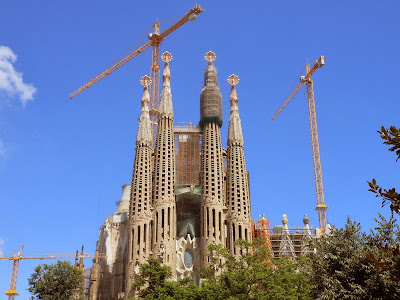 |
| La Sagrada Familia (& construction site) |
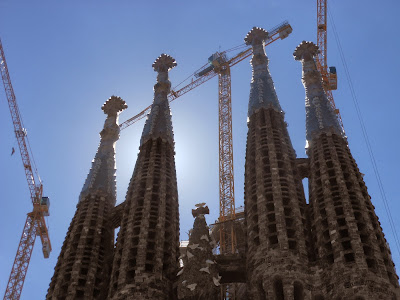 |
| Some of the finished spires against the sun |
 |
| Spire detail |
The church's design includes concepts such as Nativity, Passion and Glory façades, 18 spires (in increasing height, representing the 12 Apostles, the 4 Evangelists, the Virgin Mary and, tallest of all, Jesus Christ), interior columns designed to look like trees, and all sorts of other symbology. It was quite a bizarre building to look at, not least due to the cranes still covering the building!
Unfortunately I didn't head inside - thanks to outrageously high entrance fees - but instead took a walk up a hill to Park Güell, designed by the same Gaudí as the Sagrada Familia. Named after a Count from the early 1900s, it had some interesting mosaic designs and a great view of the city.
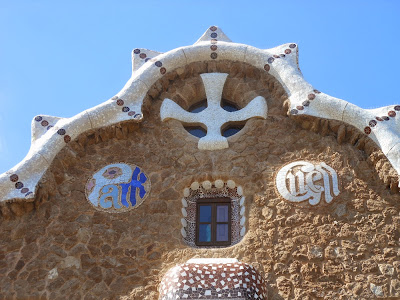 |
| Park Güell entrance |
 |
| Mosaic serpentine bench and view towards the sea |
I then took the metro off to Plaza Spanya in the south of the city and a hill called Montjuïc, which is home to Barcelona's 1992 Olympic centre - plus more of Gaudí's work and another city view. There's also the Castell de Montjuïc, a fortress with a commanding view over the city's harbour.
 |
| Looking up to the Catalunya National Art Museum |
 |
| Looking back down the hill - unfortunately missing the timing for the very impressive Font Màgica (Magic Fountain) |
 |
| Communications tower on Plaça d'Europa in the 1992 Olympics complex |
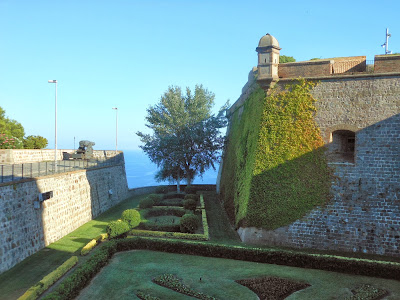 |
| Castell de Montjuïc |
 |
| View north over the city |
I spent the evening cooking my own dinner - steak! - and the next morning headed into the main city centre of Barcelona and wandered along Les Rambles/Las Ramblas, a succession of streets forming a pedestrian mall and shopping area, as well as roughly bordering the old Barri Gòtic (Gothic Quarter), where I then joined a free walking tour to see some of the inner city. Barcelona has a lot of history, having been originally founded as a Roman city, with some interesting gothic architecture in it's centre, where many more architects other than Gaudí made a name for themselves.
 |
| Gaudí's buildings are still the weirdest though. |
More recently the province of Catalunya (Catalonia), where Barcelona is based, has been the centre of a lot of debate about seceding from Spain. Much of Spain's economy is driven from Barcelona and it's surrounding area, but reportedly less than 60% of the tax earned there is spent there. Unsurprisingly, many of the locals are very keen to split into a new country - over half the population are considered to actively support independence in polling and about one quarter of the city's population turned out on the province's holiday in 2012, in support of a separate country.
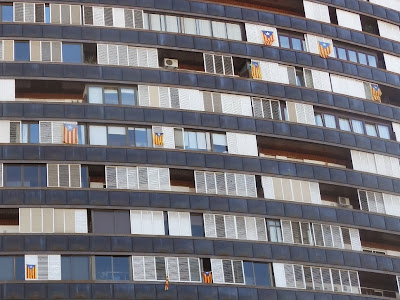 |
| Many of the supporters of Catalonian independence hang flags in their windows as a show of support - they're all over town. |
After two full days of gorgeous weather, on my third day I decided it was time to relax and gave up on the "city" sights. I spent most of the day wandering through a park, lying on the beach, getting burnt and writing in my journal (until my pen ran out), but stories of theft from bags on the beach stopped me from going for a swim, unfortunately. Certainly this beach was a true "European" beach with regards to topless bathing though...
 |
| Cascada Monumental, in the Parc de la Ciutadella |
 |
The Barcelona beach, very close to the inner city
(What, were you expecting some examples of "European" bathing?) |
First thing the next morning I headed to the bus terminal and off to Zaragoza, a city roughly south of the centre of the Pyrenees range (
Los Pirineos in Spanish). Not being in Catalonia any more was immediately noticeable, with a much higher reliance on Spanish - most of the tourists here were other Spaniards, rather than Euro-trippers.
My main reason for visiting Zaragoza was a stop-off to plan a trip into the Pyrenees for some hiking for a few days. Zaragoza itself doesn't have much in the way of tourist attractions, though I found the old centre of the city to be a very pleasant place to wander around and eat out, and with refreshingly few tourists. I did go to a local soccer match while I was there - but Real Zaragoza, playing in the second Spanish division after relegation, played pretty dreadfully though and lost 0-1 to CD Lugo.
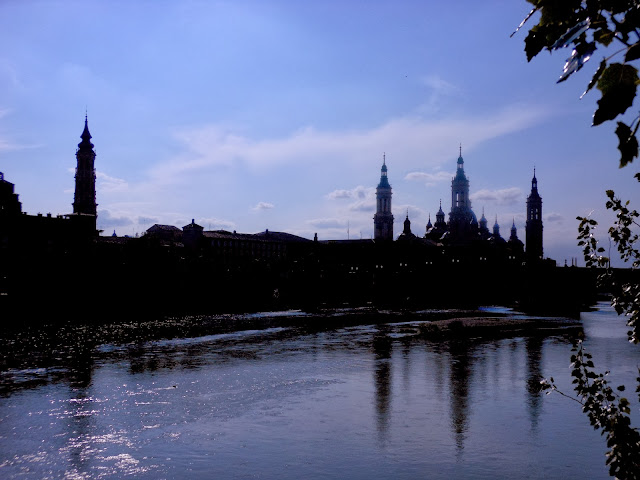 |
| Basílica de Nuestra Señora del Pilar & the Río Ebro at dusk |
 |
| The main square and Basílica de Nuestra Señora del Pilar |
 |
| A small church tower poking through a gap in the trees |
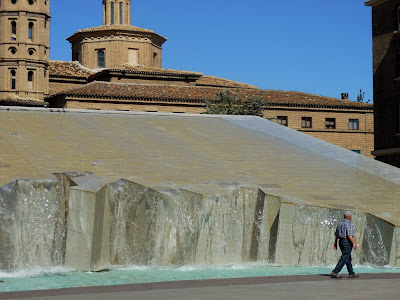 |
| A local walking past a fountain |
 |
| Odd-looking face decorations on the Ayuntamiento (Town Hall) |
The hostel I stayed in had a lot of students recently arrived for an Erasmus placement for the coming academic year - evidently the northern hemisphere summer was winding down. It also had an underground bar, and I arrived on the right day for their jazz jam sessions...
 |
| La Bóveda, the underground bar at my hostel |
After a few days there, I separated my stuff to take only outdoors gear, stocked up on food supplies, got some information from the tourist office, and headed off early one morning for the few hours bus ride to the town of Torla. It was time to get out of the cities and back into nature in one of the most famous mountain ranges in the world!